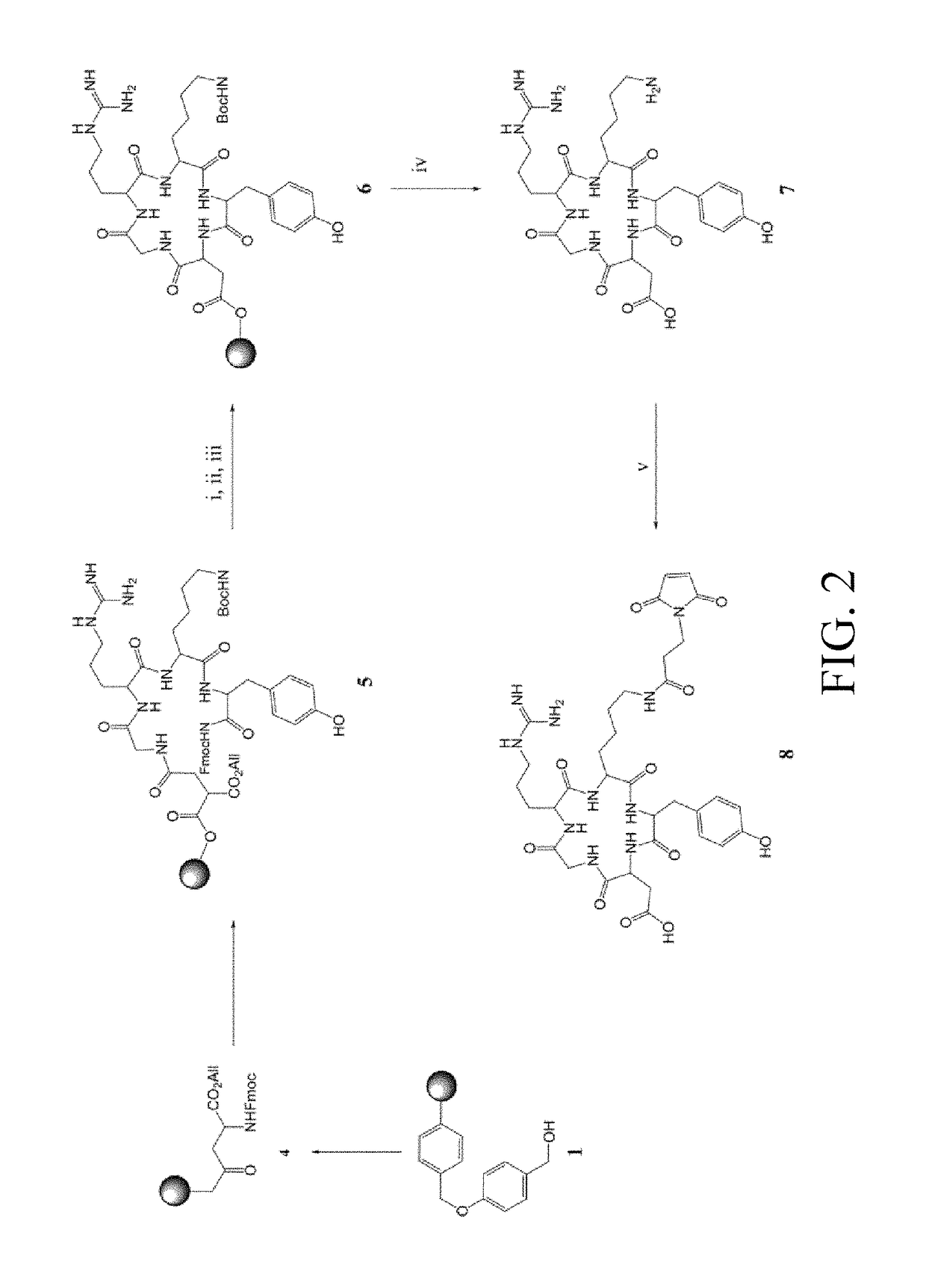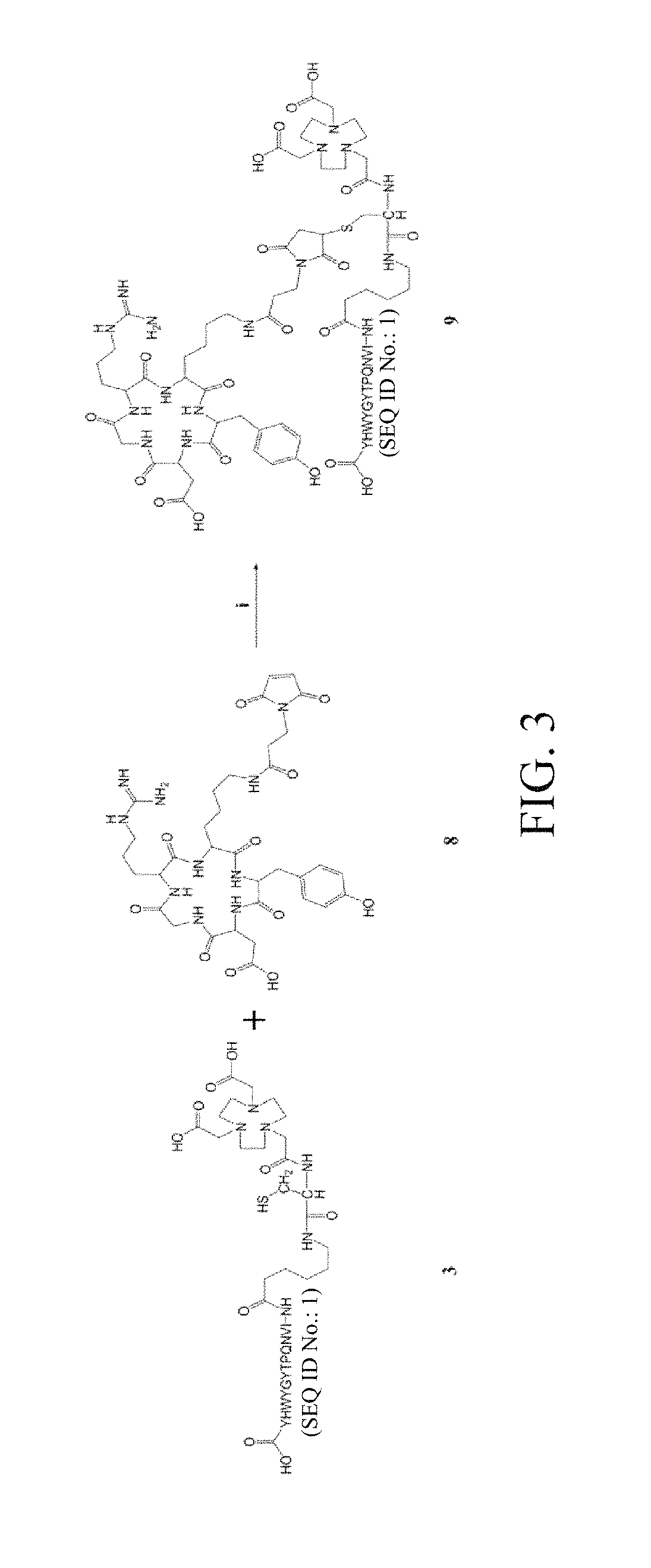Bispecific peptide conjugate and radioactive bispecific peptide imaging agent
a radioactive bispecific and peptide technology, applied in the direction of peptide/protein ingredients, peptides, peptide/protein fusion, etc., can solve the problem of unsatisfactory imaging effect, and achieve the effect of improving binding and pharmacokinetic properties
- Summary
- Abstract
- Description
- Claims
- Application Information
AI Technical Summary
Benefits of technology
Problems solved by technology
Method used
Image
Examples
example 1
Synthesis of Bispecific Peptide Conjugate
[0039]The bispecific peptide (that is, NOTA-c(RGDyk)-cys-6-ahx-GE11) used in the experimental example was prepared following the method described in Hung-Man Yu et al., J. Label Compd. Radiopharm 2015, 58 299-303. Briefly, NOTA-cys-6-ahx-GE11 was synthesized by using a peptide synthesizer, then purified by MPLC, and determined by MS to have a molecular weight of 1022.5 [M+2H]2+. The preparation process of NOTA-cys-6-ahx-GE11 is as shown in FIG. 1.
[0040]On the other hand, c(RGDyK) was synthesized by using a peptide synthesizer, then purified by MPLC, and determined by MS to have a molecular weight of 620.3 [M+2H]+ (The preparation process is as shown in FIG. 2). Maleimidopropyl-c(RGDyK) was synthesized, purified by MPLC, and determined by MS to have a molecular weight of 771.8 [M+2H]+. The preparation process of maleimidopropyl-c(RGDyK) is as shown in FIG. 2.
[0041]The NOTA-cys-6-ahx-GE11 and maleimidopropyl-c(RGDyK) thus prepared were linked, ...
example 2
Bispecific Peptide Conjugate Tagged with Radioactive 68Ga of the Present Invention
[0042]In the experimental example, the bispecific peptide bearing a radioactive tag was prepared following the method described in Hung-Man Yu et al., J. Label Compd. Radiopharm 2015, 58 299-303. The preparation method was briefly described as follows. A 68Ge / 68Ga generator was panned with 0.1N HCl, to obtain a 68GaCl3 solution. Then, 0.5 mL of 68Ga (˜185 MBq) and 0.15 mL of 1M HEPES buffer were added to 5 μg NOTA-RGD-GE11, and reacted for 15 min at room temperature. The radiochemical purity (RCP) was determined by using radio-TLC and radio-HPLC. The results are respectively shown in FIGS. 4 and 5. The bispecific peptide conjugate (68Ga-NOTA-RGD-GE11) tagged with radioactive 68Ga in this example has an RCP that is greater than 95%.
example 3
Specific Binding Assay of the Bispecific Peptide of the Present Invention for EGFR and αV Integrin (Alpha-V Integrin) in Tumor Cells
[0043]In this example, the bispecific peptide conjugate (that is, NOTA-c(RGDyk)-cys-6-ahx-GE11) prepared in Example 1 was assayed.
[0044]A549 tumor cells were plated in a 96-well plate (5×104 cells / well). Various concentrations of NOTA-c(RGDyk)-cys-6-ahx-GE11 and anti-EGFR antibody or anti-integrin αV antibody were added and reacted for 2 hrs. Then, a secondary antibody and ABTS were added and reacted for 8 hrs. The antibody binding was assayed by a fluorimeter. The experimental results are shown in FIGS. 6A and 6B.
[0045]Referring to FIGS. 6A and 6B, the specific peptide conjugate (that is, NOTA-c(RGDyk)-cys-6-ahx-GE11) of the present invention can effectively inhibit the binding of the anti-EGFR antibody and anti-integrin αV antibody to tumor cells, and the absorbance decreases with increasing concentrations of bispecific peptide of the present inventio...
PUM
| Property | Measurement | Unit |
|---|---|---|
| diameter | aaaaa | aaaaa |
| radioactive | aaaaa | aaaaa |
| retention time | aaaaa | aaaaa |
Abstract
Description
Claims
Application Information
 Login to View More
Login to View More - R&D
- Intellectual Property
- Life Sciences
- Materials
- Tech Scout
- Unparalleled Data Quality
- Higher Quality Content
- 60% Fewer Hallucinations
Browse by: Latest US Patents, China's latest patents, Technical Efficacy Thesaurus, Application Domain, Technology Topic, Popular Technical Reports.
© 2025 PatSnap. All rights reserved.Legal|Privacy policy|Modern Slavery Act Transparency Statement|Sitemap|About US| Contact US: help@patsnap.com



